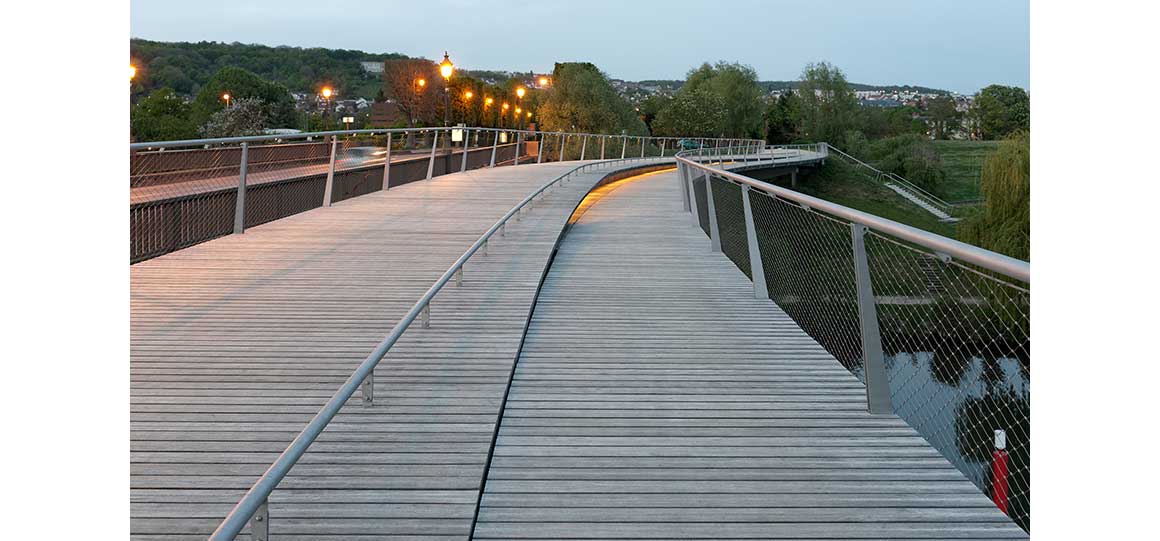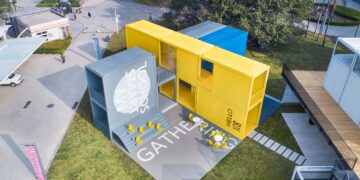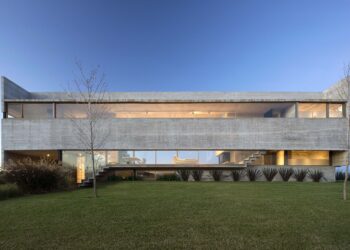A soft link between Mantes-La-Jolie and Limay
부드러운 곡선으로 두 지역을 연결하는 세느강 보행자용 다리
Dietmar Feichtinger Architectes | 디에트마르 파이히팅어 아키텍츠

Dietmar Feichtinger’s new sustainable mobility bridge over the Seine, linking Mantes-la-Jolie and Limay, is an invitation to an urban promenade. The new pathway crosses two arms of the river, pausing on the wooded slope of the Ile aux Dames, and becomes a subtle staging for urban space and the natural landscape to meet.
A double footbridge for a soft link
The first crossing is based on the existing 18th century Pont Neuf, which was rebuilt following the second world war. This relatively narrow structure opens up the town to the north, a route saturated with heavy traffic, unsuitable for pedestrians.
The new structure for the first crossing is placed at a distance from the existing bridge deck. From the bank, the footbridge appears to be flying: fine steel curves undulate between the two banks in a three-dimensional motion, continually rising and changing shape. Whether crossing by foot or bike, traffic noise is minimized. A difference in level is established between the decking of the two routes to form a bench seat. In the middle of the crossing, where the footbridge rises above the roadway, the levels meet and the passage widens to offer passers-by a view over the river.
프랑스 세느 강 위를 지나며, 망트라졸리와 리마이 두 지역을 연결하는 친환경 보행자 다리는 도시 속 산책을 즐길 수 있는 장소로서, 강의 양쪽 가장자리를 가로지르는 새로운 통로다. 목재 바닥으로 이루어진 다리는 리마이의 ‘일 오 담’ 섬을 통과하여 도시와 자연이 만나는 무대가 된다.
북쪽으로 통하는 기존 다리는 18세기에 지어진 퐁뇌프 다리와 유사한 디자인으로, 2차 세계대전 후 재건되긴 했지만 폭이 좁고 교통량이 많아 보행자에게는 적합하지 않았다.
새로 지어진 다리는 기존 다리의 데크에서 약간 거리를 두고 자리한다. 강둑에서 바라보면 공중에 붕 뜬 듯한 모습이다. 정교한 철재 구조물이 강의 양쪽 가장자리를 입체적인 곡선으로 연결하며 상승과 변형을 거듭한다. 걸어서 건너든, 자전거를 타고 건너든, 차량 소음은 잘 들리지 않는다. 높이가 다른 두 개의 보행로로 다리를 나누고, 단차가 생긴 곳은 벤치처럼 이용할 수 있도록 했다. 두 보행로는 자동차용 다리보다 높아지는 중간 지점에서 서로 합쳐져 강의 전경을 감상하기 좋은 넓은 공간을 제공한다.




A ribbon of steel and wood
Architect Dietmar Feichtinger enjoys diverting, softening and twisting structures, as well as the traditional rules of construction. Beneath the buttresses of the collegiate church, a double ribbon of steel and wood brushes against, rises above, gets closer to and then moves away from the road.
The structure is supported by the bridge abutments on either side of the river. A central caisson with a variable trapezoidal profile forms the main framework, like a spinal column to which a series of T-shaped brackets are fixed, 3m apart from one another. The watertight box girder is composed of welded metal sheets whose torsional strength enables the asymmetrical forces generated by the profile of the bridge to be transferred to the supports.
In the middle of the river, the two concrete pillars of the Pont Neuf carry the intermediate supports; consequently the new structure does not encroach on the riverbed. In each case, an inclined cross-sectional leg, fixed to the stem of the pier, takes up the vertical force, while a connecting rod ensures the stability of the entire structure. These connecting rods, embedded in the caisson, are articulated at the head of the pillars. The variable profile of the brackets makes it possible to support decks of varying widths and to absorb the differences in elevation of the decking between the two-wheeler path on the bridge side and the pedestrian path on the river side.





오스트리아 출신의 건축가 디에트마르 파이히팅어는 기존 건축 방식을 존중하면서도 꼬임과 곡선, 방향 전환을 즐기는 건축가이다. 철재와 목재로 이루어진 다리는 성당의 지지벽 아래에서부터 시작되어 서로를 스치듯 지나고, 높이 솟아 오르고, 가까이 다가갔다가 멀어진다.
강 양쪽에 설치된 접지부가 다리를 지탱한다. 다리 가운데를 지나는 케이슨에 사다리꼴 모양의 지지대 여러 개가 결합하여 척추 같은 메인 구조를 이루고, 여기에 T자 모양의 브래킷이 3m 간격으로 설치되어 있다. 물을 차단하는 박스 대들보는 휘는 속성이 있는 금속판으로 이루어져, 다리의 구조에서 비롯된 비대칭 에너지를 지지력으로 바꿔준다.
강 중간부, 기존 다리를 지탱하는 두 개의 콘크리트 기둥이 새 다리를 떠받쳐 준 덕분에 강바닥에 지지대를 따로 설치할 필요가 없게 됐다. 새 다리의 등줄기에 고정된 경사진 받침대가 수직으로 작용하는 힘을 버텨주고, 서로 연결된 강철 구조물이 전체 구조를 안정적으로 유지해 준다. 케이슨에 박혀있는 이 강철 구조물은 기둥 머리와 연결되어 있다. T자 모양 브래킷은 필요에 따라 움직일 수 있는 구조여서 너비가 달라지는 데크를 효과적으로 받쳐줄 뿐 아니라, 기존 자동차용 다리와 새로 지은 보행자용 다리 사이의 높이 차도 문제 없이 조정해 준다.



Bringing a historic route back to life
On the island, the urban walkway continues round the open-air theatre like a balcony and brings the collegiate church into view. The route will be fully functional once restoration work on the Vieux Pont has been completed. This historic bridge, two of whose central spans were destroyed in 1940, will be fitted with a discreet fine steel framework to repair it. The route ends with the Vieux Pont, at a public square, which will come alive once again with the arrival of pedestrians and cyclists.

새 다리는 세느 강에 떠 있는 일 오 담 섬과 연결되어 이곳의 발코니형 야외 공연장을 지나 성당의 경치를 불러들인다. 현재 복원이 진행 중인 비에유 다리가 완공되면 기능 면에서 더욱 완벽해질 것이다. 비에유 다리는 리마이 지역에서 오랜 역사를 지닌 다리이지만, 1940년 가운데 두 구간이 붕괴되어 현재 철제 프레임을 이용한 세심한 복원 작업이 진행되고 있다. 새로운 보행자 다리가 끝을 맺는 비에유 다리 광장은 걸어서, 혹은 또는 자전거를 타고 도착하는 사람들이 모여 과거처럼 다시 북적이게 될 것이다.
Project: Footbridges over the Seine River for pedestrians and cyclists / Location: connecting Mantes-la-Jolie and Limay, France / Architect: Dietmar Feichtinger Architectes / Consulting engineers: Terrell SAS / Other planners: Coup d’éclat / Contractors: RAZEL-BEC / Steel construction: Stahlkonstruktion / Reinforced concrete: Stahlbeton / Excavation on site: Baugrubenaushub / Height above street level: Höhe über Straße / Client: SMSO, EPAMSA / Total length: Grande passerelle_202m, Franchissement Vieux Pont_24.5m / Clear span: 67m, 59m, 62m / Width: grande passerelle_variable 6~7m, franchissement Vieux Pont_variable 4.4~6m / Cost: EUR 4,656,000 / Design: 2012.4 / Construction: 2016.12~2019 / Photograph: David Boureau, Dietmar Feichtinger Architectes




































